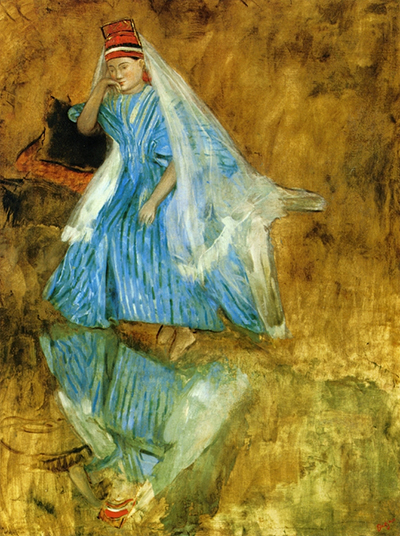The stunning oil on canvas painting showcases Mademoiselle Fiocre, a famous Parisian dancer during the 19th century.
The painting highly resembles the artist's other work, Mlle Fiocre In The Ballet "The Source". Rather than focusing on the scene yet again, Degas decides to focus on the focal point being Mademoiselle Fiocre. This stunning painting showcases the star of the show sitting in a rock as she out below. The woman is dressed in a beautiful blue dress that covers her chest, arms, and legs. Degas uses different shades of blue in both light and dark colours to illustrate the beautiful material. The blue lines fill the fabric in a linear pattern alternating between light and dark shades of blue. The dress is singed at the waist, later flowing out towards the arms.
On the woman's head, a deep red ethnic hat lays. A white and black line cover the perimeter in a decorative manner. Attached to the back of the red hat, a stunning white veil falls onto the woman, covering half of her body. As Degas had immense experience showcasing the beautiful material of ballerina's costumes, he uses this skill to illustrate the woman's veil. The viewer can witness the thin sheer material of the veil that lightly falls upon the woman. It's absolutely brilliant to witness the artist showcase his material, while still letting the blue pattern underneath show. This meticulous attention and skill are one of the artistÕs most brilliant qualities that earned him the reputation of being one of the most brilliant artists of his time.
The viewer can witness a vast stretch of the bottom of the canvas covered in water. The artist's Impressionism style gently merged the harsh lines together, making it difficult to exactly find where the shore begins, and where it ends. Yet, you can spot the woman gently place her feet in the water beneath her. The woman leans against her right arm as she looks into her reflection in the water. Degas slightly reflects her being into the water, based on the perspective of the viewer. Rather than perfectly showcasing her reflection onto the water, Degas gently illustrates the colour of her dress in a greener hue. His face is difficult to recognize, besides her red hat.
Degas gently uses these stunning techniques to showcase the detail and texture of the surface of the water. The still water allows for the reflection of the woman to be seen in immense detail. The woman leans on a black fabric, that lays upon a red fabric. It seems as if the woman had traveled for endless miles and has finally reached the small body of water. The background of the piece is covered in a golden-brown colour. Degas uses deep brush strokes to create the illusion of a background filled with rocks. Yet, rather he simply uses long brush strokes to create the background. Degas mixes the different brown shades into one another, while adding hints of black, gold, and green.
The artist uses a deeper hue of green towards the surface of the water to create a slight distinction. Yet rather than using a blue to showcase the water, the artist does an exact reflection based on the background of the painting. These illuminating gold shades add a stunning element of warmth to the piece. Alongside, a luxurious effect is added. These beautiful shades merge into one another endlessly, adding life and light to the portrait. The final question that remains is what exactly is on the woman's mind as she stares at the water. Is she pondering a deep question, or recent event. Yet the truth remains unknown buried beneath the surface of the canvas.




